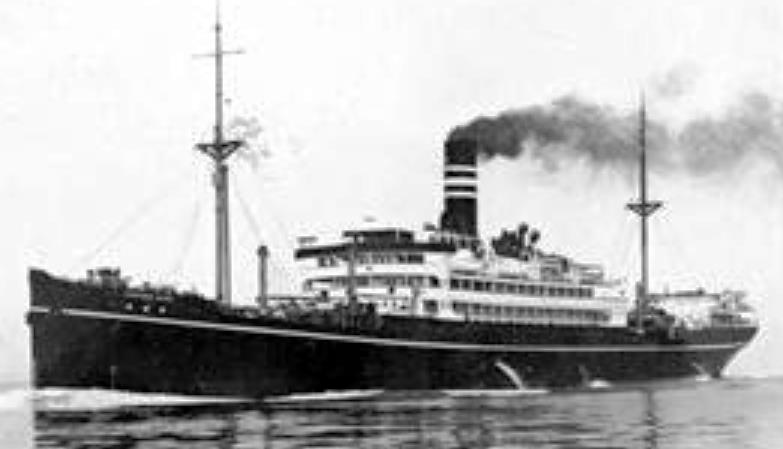RIKUGUN YUSOSEN
 (NYK Liner TSS HARUNA MARU, prewar)
(NYK Liner TSS HARUNA MARU, prewar)
IJA Transport HARUNA MARU:
Tabular Record of
Movement
© 2016 Bob Hackett
10 September 1920:
Nagasaki. Laid down at Mitsubishi Shipbuilding Co., Ltd. as Yard No. 347, a 10,421-ton passenger-cargo-ship for Nippon Yusen Kabushiki Kaisha (NYK Line), Tokyo.
5 November 1921:
Launched and named HARUNA MARU.
31 January 1921:
Completed. HARUNA MARU can carry 118 first-class passengers, 55 second class and about 134 third class passengers.
April 1922-March 1923:
HARUNA MARU is on NYK's Yokohama ~ North European route with ports of call at Kobe, Moji, Shanghai, Hong Kong B.C.C., Singapore, Malacca, Penang, Colombo, Suez, Port Said, Marseilles, London and Antwerp.
Penang, Malacca and Moji are omitted on return voyages.
8 March 1922:
HARUNA MARU departs Singapore for London.
10 August 1922:
HARUNA MARU departs Singapore for London.
29 December 1922:
In September 1921, Dr. Albert Einstein had been invited by the Japanese journal Kaizo to embark on a lecture tour of Japan. In late 1922, Einstein and his wife embark on a five-and-a-half-month trip to the Far East, Palestine,
and Spain. Einstein’s motivation for accepting the invitation to Japan is to fulfil his long-term desire to visit the Far East, to enjoy two long sea voyages and to escape from Berlin for several months in the wake of the recent
assassination of Germany’s Foreign Minister by anti-Semitic right-wing extremists. There was reason to believe that Einstein’s life was also at risk. After a highly successful stay in Japan, the Einsteins board NYK's HARUNA MARU
at Moji and depart Japan. A month later, they arrive in the British Mandate of Palestine where they stay for 12 days.
August 1926-March 1927:
HARUNA MARU is on NYK's Yokohama ~ North European route with ports of call at Kobe, Moji, Shanghai, Hong Kong, Singapore, Malacca, Penang, Colombo, Aden, Suez, Port Said, Marseilles, Gibraltar, London, Antwerp.
Return voyages now from Middlesborough, calling at Naples, omitting Aden, Penang, Malacca and Moji.
January 1938:
The London Communist Party distributes leaflets to London dockers, calling on the stevedores in Middlesbrough to refuse to load HARUNA MARU with a cargo of pig iron destined for Japan. The stevedores comply with the Communists.
January 1930-March 1931:
HARUNA MARU is on NYK's Yokohama ~ London route with ports of call at Yokohama, Kobe, Moji, Shanghai, Hong Kong, Singapore, Penang, Colombo, Suez, Port Said, Marseilles, Gibraltar, London. Calls at Yokkaichi, Osaka, Aden and Naples on
most voyages. Calls at Naples, omitting Aden, Penang, Moji, Osaka and Yokkaichi on return voyages.
30 May 1932:Los Angeles Olympics.
HARUNA MARU departs Colombo, Ceylon (Sri Lanka) for Singapore carrying the 16-member Indian Olympic hockey team. During the onward journey to Hong Kong, many players fall ill due to the rough weather. The team next steams to Tokyo,
Honolulu, and reaches the port of San Pedro at Los Angeles, California some three weeks before the start of the Olympic Games.
April-October 1935:
HARUNA MARU is on NYK's Yokohama ~ London route with ports of call at Nagoya, Osaka, Kobe, Moji, Shanghai, Hong Kong, London. Moji and Nagoya omitted on return voyages.
March 1938-March 1939:
HARUNA MARU is on NYK's Yokohama ~ London route with ports of call at Nagoya, Osaka, Kobe, Mozi, Keelung, Shanghai, Hong Kong, Singapore, Penang, Colombo, Aden, Suez, Port Said, Naples, Marseilles, Gibraltar, London.
Aden, Penang, Mozi, Osaka and Nagoya omitted on return voyages.
18 October 1941:
Requisitioned by the Imperial Army (IJA) as a troop transport. Alloted IJA No. 848.
8 December 1941: Operation "M" - The Attack on the Southern Philippines:
At 0800, HARUNA MARU departs Peleliu, Palau Islands for Legaspi, Luzon, Philippines in Rear Admiral (later Vice Admiral) Kubo Kyuji 's (38)(former CO of KAGA) Fourth Surprise Attack Force with IJA transports MATSUMOTO, MYOKO,
SHINANOGAWA and YASUKAWA MARUs and IJN transports SHINRYU and YAMAFUKU MARUs. Kubo’s force is escorted by light cruiser NAGARA (F), DesDiv 24's KAWAKAZE, SUZUKAZE, UMIKAZE and YAMAKAZE and minelayer AOTAKA. Kubo’s force is also
accompanied by oiler IJN HAYATOMO and DesDiv 16’s YUKIKAZE and TOKITSUKAZE. Seaplane tenders CHITOSE and MIZUHO provide air cover.
11 December 1941:
Off Western Luzon, Philippines. Enroute to Legaspi, the convoy’s destroyers refuel from oiler HAYATOMO.
12 December 1941:
At 0400, A submarine is detected near the landing force. AOTAKA and patrol boat PB-34 are briefly detached for a depth-charge attack.
Beginning at about 1200, Kubo's Fourth Surprise Attack Force lands troops at Legaspi.
19 March 1942: "U" transport operation to Burma (U Sakusen):
The First Burma Transport Convoy departs Singapore consisting of 32 ships with main body of the 56th Division: HARUNA, AOBASAN, GENOA, GLASGOW, HAVRE, HIBURI,
HOFUKU, HOKUMEI, KAZUURA, KIZAN, KUSUYAMA, KOTOHIRA, MYOKO, MOMOYAMA, NAKO, NAGARA, NICHIRAN, NAPLES, SANKO, SAKITO, SHINAI, SHINANOGAWA, SHINRYU, SHUNSEI, SYDNEY, SUMATRA, TATEISHI, TSUYAMA, TOKIWA and YAE MARUs and two others.
25 March 1942:
The First Burma Transport Convoy arrives at Rangoon, Burma (now Yangon, Myanmar).
7 July 1942:
HARUNA MARU departs Kobe for Yokohama carrying a cargo of rice and sugar, but in dense fog runs aground on a reef east of Omaezaki lighthouse at 34-35N, 138-15E. On receipt of the news, survey ship IJN KOMAHASHI is dispatched from Yokosuka
to participate in the rescue of survivors.
8 July 1942:
KOMAHASHI remains in attendance at the wreck site of HARUNA MARU while salvage tugs unsuccessfully attempt to refloat the ship.
21 July 1942:
During salvage operations, hull cutting causes HARUNA MARU to rollover and sink.
Author's Notes:
Thanks go to Erich Muehlthaler of Germany.
Bob Hackett
Back to
IJA Transports





